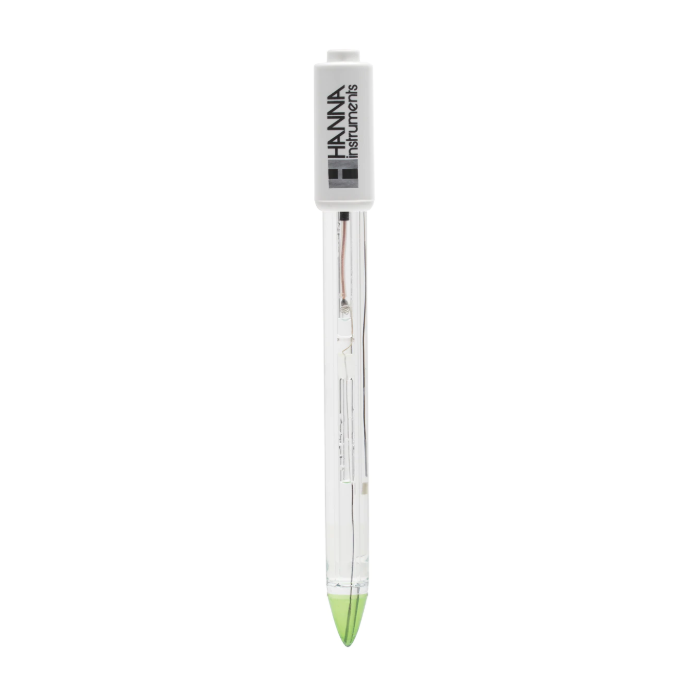pH Electrode for Yogurt and Creams (FoodCare) with BNC Connector - FC210B
- Low Temperature Glass
- Conical Tip
- Open Junction
Hanna Instruments offers a wide variety of pH electrodes that are designed for many different applications. The type of glass used for sensing pH, bulb shape, body material, type of junction, type of reference and electrolyte used are just some of the design considerations.
The FC210B is a double junction pH electrode that uses low temperature (LT) glass, conical bulb, glass body, and open junction with viscolene gel electrolyte.
Low Temperature Glass Formulation
The glass tip uses a special LT glass formulation with a lower resistance of approximately 50 megaohms compared to general purpose (GP) with a resistance of about 100 megaohms. This is beneficial since many food products are stored at low temperatures. As the temperature of the glass decreases in the sample, the resistance of the LT glass will increase approaching that of GP glass at ambient temperatures. If using GP glass, the resistance would increase above the optimum resistance for the high impedance input of a pH meter.The FC210B is suitable to use with samples that measure from 0 to 50°C.
Conical Glass Tip
The conical shaped tip design allows for penetration into solids, semi solids, and emulsions for the direct measurement of pH in food products including meat, cheese, yogurt, and milk.
Glass Body
The glass body is ideal for laboratory use. The glass is resistant to many harsh chemicals and is easily cleaned. The glass body also allow for a fast transfer of heat to the internal reference electrolyte. The mV generated by the reference cell is temperature dependent. The faster the equilibrium the steadier the reference potential.
Open Junction Reference
Suspended solids and proteins found in food products will clog a conventional ceramic reference junction. This clogging will impede the measurement circuit between the indicating electrode and the internal reference resulting in slower response time, erratic readings, and frequent electrode replacement. The open junction design consists of a solid gel interface (viscolene) between the sample and internal Ag/AgCl reference. This interface not only prevents silver from entering the sample, but also makes it impermeable to clogging, resulting in a fast response and stable readings.
BNC Connector
The FC210B uses a BNC connector. This type of connector is universal in that it can be used on any pH meter that has the female BNC probe input. Other type of connectors include DIN, screw type, T-type, and 3.5mm to name a few. These types of connectors tend to be proprietary for a particular type of meter and are not interchangeable.
Single Junction Versus Double Junction pH Electrodes
Conventional electrodes are normally single junction. As depicted by the figure above, these electrodes have only a single junction between the internal reference wire and the external solution. Under adverse conditions, such as high pressure, high temperature, highly acidic or alkaline solutions, the positive flow of the electrolyte through the junction is often reversed resulting in the ingress of sample solution into the reference compartment. If this is left unchecked, the reference electrode can become contaminated, leading to complete electrode failure. Another potential problem with single junction electrodes is the clogging of the junction due to silver chloride (AgCl) precipitation. Silver can be easily precipitate in samples that contain Tris buffer or heavy metals. When the electrolyte solution makes contact with the sample, some AgCl will precipitate on the external face of the junction. The result is drifty readings obtained from the sensor.
Hanna’s double junction system, as the name implies, has two junctions, only one of which is in contact with the sample as shown in the figure. Under adverse conditions, the same tendency of sample ingress is evident. However, as the reference electrode system is separated physically from the intermediate electrolyte area, the contamination of the electrode is minimized. The likelihood of clogging of the junction is also reduced with a double junction electrode since the outer reference cell uses a fill solution that is “silver-free”. Since there is no silver present, there is no precipitate forming to clog the junction.
Specifications
|
Body Material |
Glass |
|
Reference |
double, Ag/AgCl |
|
Junction/Flow rate |
open |
|
Electrolyte |
Viscolene |
|
Range |
pH: 0 to 12 |
|
Max. pressure |
0.1 bar |
|
Tip shape |
conic (6 x 10 mm) |
|
Recommended Operating Temperature |
0 to 50°C (32 to 122°F) - LT |
|
Temperature sensor |
No |
|
Amplifier |
No |
|
Cable |
coaxial; 1 m (3.3’) |
|
Connection |
BNC |
| Fast Shipping | No |
|---|

